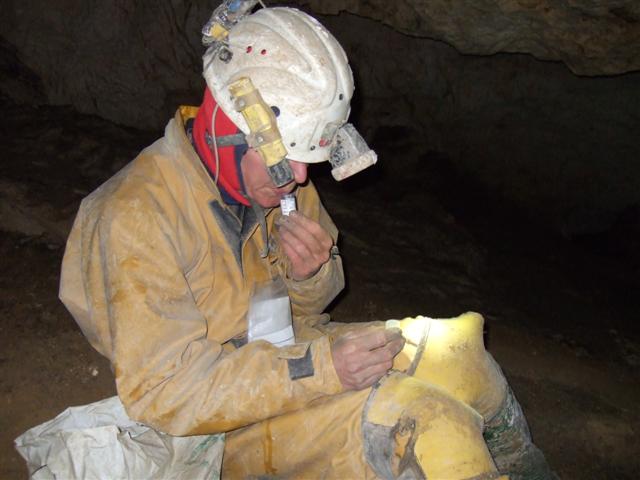
Cambridge University Caving Club's latest expedition mapped an unprecedented 7.6km while stress, microclimate, and radon studies gave a scientific focus to the expo. Aaron Curtis reports. Originally published in Speleology 10, pages 10-14.
The appointment of a rookie leader must increase an expedition's chance of catastrophic failure. In a strange way, it seems also to improve the odds of a wildly successful summer. Far less than the appropriate level of trepidation was involved when I made some ambitious decisions regarding the game plan for Cambridge 's 2007 expedition. With no trips deeper than -200m under my belt, I couldn't have fully understood what it means to rig and derig a tight rift to -600m, while simultaneously conducting a separate push below -400m, and carrying out three scientific investigations. I had a vague idea that it wouldn't be easy; but I also had a nagging feeling that the Cambridge caving community had huge potential, unrealized in recent years. Fortunately, the latter underestimation far outweighed the former.
The promise of some hard caving brought out the best in CUCC and ExCS (the ex-Cambridge Speleologists). Caving legends crawled out of the metalwork in their PVC and kneepads, novices were inspired. The resulting snowball effect left us with a six week expedition consisting of 31 cavers : up from last year's 12. Keenness permeated the expedition, and not just from those who were returning after decades away. The novices showed their stuff as Ollie Stevens broke the 150 hours of caving mark, Edvin Deadman and Kathryn Hopkins proved a dynamic duo, bringing back 440m of survey in a single trip with Nial Peters, and Djuke Veldhuis collected more spit than you could shake a Bunde branch at.
 |
The stress study was part of the new expedition emphasis on science. More than a year before expo, I began to think about conducting the research for my undergraduate geography dissertation on the expedition. The idea of becoming the lone researcher in a den of cavers made me nervous. Then one evening at the pub, Djuke started talking about milking cavers for spit. Whether or not it was drunken babble, she stood by it. I began speaking with scientists who were expo alumni and realized that expo had tremendous unrealized potential for science : excellent infrastructure, undisturbed environments, and intelligent minds. Despite talk of how tradition runs deep and major changes were likely to meet resistance, I encountered only support for my attempt to re-invent the expedition. In hindsight, someone could have pointed out that "The Cambridge Austrian Cave Science Expedition Two Thousand and Seven" doesn't exactly roll off of the tongue.

|
It seemed I would have some very expensive toys indeed. Nial unfurled the 2005 survey with such dramatic gusto at our Royal Geographical Society interview in London that they offered us £2000 towards the project for thermistors, dataloggers, and a new set of top camp solar panels. Club members would also put long hours into the construction of two devices designed by Dr Neville Michie, an Australian cave climatologist who was instrumental in assisting our plans. Additionally, the geography department offered to lend a weather station and a thermal camera worth £30,000 for observing cave wall thermal gradients.
In the field, those toys provided very little opportunity for playing:it was exhausting work transporting, setting up, troubleshooting, and collecting data. Some of the technology disappointed us. The thermal camera was unavailable because it malfunctioned while in use on a volcano in Ethiopia shortly before we left. The sonic anemometer which I had put months of work into building proved too finicky for underground use. Olly Madge's micropsychrometer never made it underground : I broke the fragile thermopile assembly at top camp while trying to attach a wet wick. A week of weather station data was lost during a battery change.
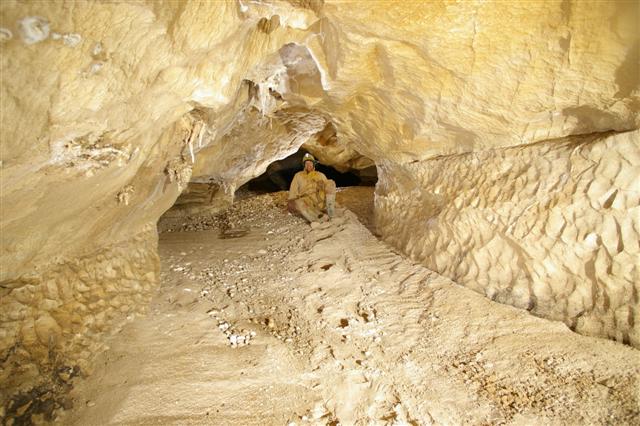
|
Prof Mark Dougherty was also engaged in the glorious endeavour of sticking gadgets down caves in expo's third investigation. A newly developed Swedish radon detector technology claimed to provide faster, cheaper results than traditional detectors. Mark's detectors were placed at depths ranging from the surface to -438m, and in a variety of caves: Steinbrückenhöhle, Kaninchenhöhle, and Eislufthöhle. The deepest detector was stationed at God Loves a Drunk in Razordance, and witnessed many an exhausted caver.
It is surprising how quickly 1.8km of tight rift, punctuated by 28 pitches, can fly by : at least, in comparison to what it takes to drag yourself back out. Returning from my first trip into Razordance, I was asked how I found it. "Far, far harder than anything else I've ever done in my life," I said, "But not all that bad, really."
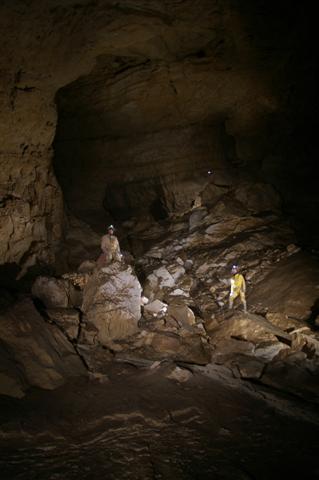 |
The 2006 extent of exploration in Razordance stood at -520m. After three rigging trips, the pushing began. Pitch, tight rift, pitch, tight rift : at first it looked like more of the same. The evening before I left for a one week trip to the USA to attend my grandmother's memorial celebration, I was anxious to know if the vertical extent of Steinbrückenhöhle had broken the -600m milestone. We typed in the survey data and out popped the shocking result: -599.99m. Razordance was toying with us.
Shortly after I left, it sumped, leaving the cave at 622m deep. By the fourth week the pushing front was back up to -485m. Their ravenous appetite for cave far from satiated, the explorers traversed over the sump and into upward sloping sandy phreas, dubbed The Silk Road. Impressive formations appeared, including a fine trio of straw / stalactites and an odd mushroom-shaped erosion feature. After 200m of climbs and steep passage, the tubes opened up into the largest chamber CUCC has seen in recent years.
While my friends crawled along sandy passage, I reclined on sandy beaches in Maryland. On my return I met the news of the accomplishments in Razordance with amazement, and realized I could miss my chance to see the new stuff if I didn't get down there quickly. I volunteered for the first major derigging trip to the bottom, expecting that we would have time for a quick look at the sump, and then at least I would have met the incredible: the end of a seemingly interminable streamway.
Things didn't go as planned. Instead, when I returned to the surface, I felt lucky to have escaped meeting my own end. The descent went without a hitch, and the streamway behaved as always:gently trickling around our ankles and dripping down pitches. Jon Telling was leading the trip, followed by myself and then John Billings. I reached the bottom of the final pitch, dubbed Zwack. Jon turned to me and asked "Do you notice anything unusual about the water?" "Nah," I said, "let's go see the sump." I was frustrated that this reliable, solid caver was getting cold feet for no apparent reason. If only I knew how cold my feet were about to become!
 |
Within a minute, the trickle had turned into a waterfall. Before John Billings even made it down the last pitch, that waterfall was a raging torrent. There was some excitement as Jon and I waved him back up the pitch only to discover he couldn't change over. He'd left his chest jammer off, planning to rejig his gear before ascending.
Just add water, and Razordance becomes a different place entirely. If it was toying with us earlier, now I truly felt like its helpless plaything. All of the 28 pitches became waterfalls, half of which cascaded directly down the rope. What had been somewhat slippery ground now reacted like an ice rink. The unceasing roar of the water made communication all but impossible. We were all soaked to the bone in 2°C. I found the noise was as difficult to deal with as the wet and cold. Struggling to squeeze my heavily packed and soaking tacklesack and shivering body along the rift, I wondered, for the first time ever, if I might not see the surface again.
The derigging trip was in three waves : I was in the first wave of three people, and two waves of two followed. The considerate actions of the second and third waves gave me new hope and warmed me literally and figuratively. First, I encountered Mark Dougherty, who had come ahead to help with some of the rope. When we made it to God Loves a Drunk, those behind us had cooked some hot food (thank you, Be-Well!) from the dump we'd established there. They had also rigged an extra pitch which was no longer free-climbable due to the storm surge.
Despite the difficult conditions, the seven of us hauled out all of the rope to the beginning of Razordance. A second trip of four people paellaed it to the entrance pitch, where those on the surface lent several hands. The resulting heap of muddy rope glistened in the moonlight like a thousand-tentacled deep-sea creature, settling its bulk down in odd contentment on the moonlit limestone slabs in front of the stone bridge.
At the end of exploration, we had surveyed to within 40m of Kaninchen-höhle's Midnight in Moscow . Future attempts at a connection will most likely be made from the Kaninchenhöhle side, and discussion is already underway for such a trip next summer.
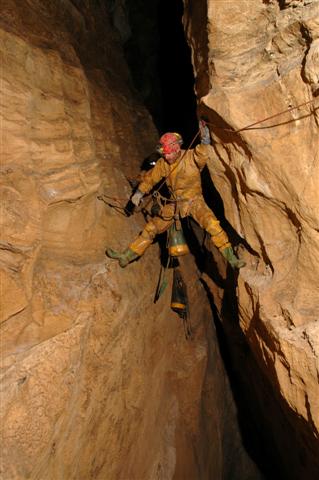 |
While we'd like to say it was teamwork and cooperation that led to successes in two deep leads simultaneously, it seems that 'friendly' competition worked just as well. Un-British rope grabbing and name calling began when it became clear that the budgeted 2.5km of rope would be used to the very last metre. Nial Peters mustered a group of cavers who felt that Razordance ('Pussyprance') was for wimps, and the real action was in the stratigraphically deepest, maze-like levels of Steinbrücken, accessed via the 80m Gaffer Tape pitch and following series.
Indeed the explorers met action in great measure down at -400m, and mud in even greater measure. Prussiking is another game entirely when both jammers refuse to grip the rope. We pulled ourselves up by our rather slippery bootstraps. Edvin Deadman wrote in his diary that "you can't tell your jammers from your krabs as they are all one big brown mass!" The day after a trip down Gaffered I watched Martin Green doing his best to don a pair of still-slimy wellies. In the end, ingenuity prevailed and a pair of pliers pulled the boots on.
Several surveying marathons (including one 22-hour trip) later, a new horizontal level dubbed the Convenience Series had appeared on the survey, perched vertically between Subsoil and Subway. Plumbing-themed discoveries including Don't Worry, Pee Happy, Indecent Exposure, and Out of Order Rift amounted to 909m of survey, including several loop closures. The lowest pitch drops down into the Subway level (the lowest level in that area) and comes within 6m of passage there, but so far has failed to connect. The logbook explains that the final pitch is dubbed SLTR for "reasons known only to its explorers." Since our expedition is cooperative, not competitive, we can rest assured that whatever it stands for, it surely isn't Stratigraphically Lower Than Razordance.
On the 2006 expedition, I remember peering down the underground snow slope where exhausting hours of hand bolting had landed us in the days following the discovery of Tunnockschacht. The snow extended down into the distance, towards the sheer wall far in front of us. My heart sank when I thought I could make out the snow meeting the wall, with no way on. Several rebelays further on, I reported seeing what looked like a patch of dirty snow where the slope met the sheer wall. After gaining the bottom of the 70m snow slope, that 'patch of dirty snow' turned out to be a beautiful, ~5m high archway leading into a phreatic horizontal system. By the end of that expo, 500m was surveyed and many of us were excited by its potential:hoping for extensive horizontal passage and possibly a connection with Steinbrückenhöhle.
We had no idea. After derigging around 2.5km of rope from Razordance and the Gaffered trips, the expedition welcomed some horizontal caving, and we turned our expectant eyes on Tunnockschacht. It did not disappoint : stomping passage shot off northwards into realms of spellbinding beauty, and spectacular underground voids, bristling with grade-A leads. The only real difficulty was evading the formations which attacked from all sides and appeared underfoot with a sickening crunch. Our efforts at installing conservation tape seemed somewhat absurd and it was noted more than once that the only logical place to put the tape would be across the entrance.
Tunnockschacht is now 3km long and within a stone's throw of Grießkogelschacht, which the German club Arbeitsgemeinschaft Höhle und Karst Grabenstetten e.V (ARGE) is exploring. ARGE visited us in Bad Aussee, during a dinner with the town mayor, who presented us with an award for 25 years of service to the area. Ironically, our companions decried the lack of horizontal cave in their area : their expedition had met with blind shaft after blind shaft. If Tunnockschacht connects to Grießkogelschacht, we'll all be scratching our heads.
A few cavers pushed Tunnockschacht in the opposite direction: south, towards Steinbrückenhöhle. Here, Tunnockschacht is less of a stomping wonderland and something more akin to normal cave. Ollie Stevens and I, with initial help from Frank Tully and Pete Harley, travelled to the southernmost 'question mark' (QM) and dropped two pitches. Ollie enjoyed his Pantin foot jammer : which facilitated ropewalking up the smooth, slightly inclined pitch so much that we named it the Pantin Sales Pitch. A second pitch dropped 40m through a cavernous rift into a boulder choke. There are still two QMs which provide hope for a Steinbrücken - Tunnocks connection, but pushing them will require diverting attention from the attractive northern leads.
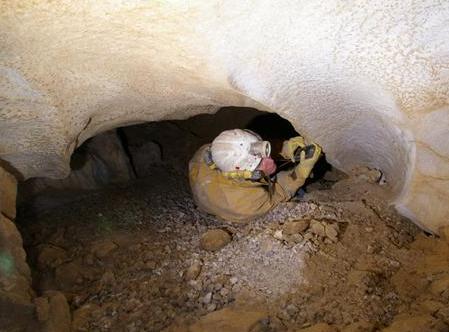 |
Continuing south, far past Stienbruckenhöhle, Olly Betts and Jenny Black continued their work from their plateau camp. Warm invitations had been extended to the Steinbrückenhöhle crew, but we were all wrapped up in our own projects. Olly and Jenny miraculously turned four of our caves, 81, 82, 85, and 148, into one and a half by finding connections between 82 and 85, and 81 and 148. 81 and 85 could be seen as connected because they discovered a new 81 entrance in the same doline as the 85 entrance.
Eislufthöhle (76), yielded a new pitch series, the Sea of Holes , as did Marilyn Munroe Höhle (148), called Deep Space. The latter cave had admitted no human beings since 1987, and upon entering, Olly and Jenny made an intriguing discovery. There was a page of survey notes on the floor of a passage, still legible after 20 years. Safely removing them from the cave appeared impossible, but photos were taken. We have so far failed to figure out what part of the real world the survey corresponds to. The legs are very long, suggesting a surface survey. Personally, I suspect they lead to buried treasure.
Buried treasure is precisely what CUCC has been digging up for the past 31 years in Austria . If I am to leave a lasting mark on the expedition, I hope it will be the inclusion of plentiful scientific data in our annual haul. There is no denying that the potential for a giant connected system incorporating Tunnocks, Steinbrücken, and Kaninchenhöhle are exciting. However, I hope we continue to investigate these caves in an attempt not merely to map them, but also to understand them. ¢
We would like to thank the Royal Geographical Society, Ghar Parau Foundation, the BCRA Cave Science and Technology Research Initiative, and the Cambridge Expeditions Committee for their invaluable support and funding.
Equipment and consumables integral to the expedition were provided by our corporate sponsors: Princeton Tec, Peli, Tunnocks, Mickie's Place, Mornflake, Silva, Whitworths, and Hilti.
Thanks go also to our Austrian contacts, especially Hilde Wilpernig and the Gasthof Staud'n'wirt, Robert Seebacher of the Verein fur Höhlenkunde in Obersteier and the workers of the Loser Panoramastrasse.
Aaron Curtis, Andrew Atkinson, Anthony Day, Andreas Forsberg, Becka Lawson, Dave Löffler, Djuke Veldhuis, Duncan Collis, Edvin Deadman, Frank Tulley, George North, James Carlisle, Jenny Black, John Billings, Jon Telling, Julian Todd, Julia Bradshaw, Kathryn Hopkins, Mark Shinwell, Mark Dougherty, Martin Green, Morven Beranek-Stanley, Nial Peters, Olly Betts, Ollie Stevens, Phil Underwood, Pete Harley, Richard Mundy, Wookey.
Further Reading
Loeffler, D (2004) Expedition Report: Totes Gebirge , Austria 2003. Speleology 4 , pp10-12.
Peters, N (2006) Expedition Report: Totes Gebirge , Austria 2005. Speleology 6 , pp10-13.
Shinwell, M (2007) Shafts, Streamways, & Surveying: Totes Gebirge , Austria 2006. Speleology 8 , pp14-17.
Aaron Curtis (ac511 - at - cam.ac.uk)
Expedition Leader 2007
Robinson College, Cambridge, CB3 9AN, UK
3th June 2008